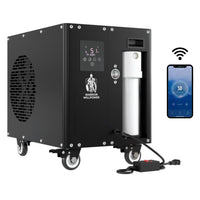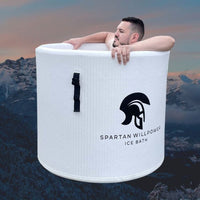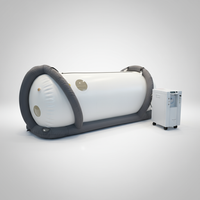Jumping into near-freezing water might feel like torture. Yet thousands of athletes and fitness enthusiasts choose ice baths as part of their daily routine. Scientists have become increasingly curious about ice baths and their effects. They want to learn about what happens to our bodies during cold water immersion.
The practice has ancient roots, and modern science confirms what athletes suspected. Ice bath benefits are way beyond the reach and influence of simple muscle recovery. These benefits impact everything from our cardiovascular system to our mental well-being. Ice baths and cold plunges have gained popularity, but people still wonder if the discomfort brings enough benefits.
Let's look closely at the research and separate fact from fiction. The science behind ice baths reveals fascinating insights. Our detailed analysis covers muscle recovery mechanisms and mental health effects. This information will help you decide if this challenging practice deserves a spot in your wellness routine.
The Science Behind Cold Water Immersion
The human body launches a chain of responses when we dive into cold water. Scientists have spent years trying to break down what happens when we take that chilly plunge.
Understanding the physiological response
Our bodies react immediately to cold water through what scientists call the "cold shock response." This triggers several things at once - we breathe faster, our heart rate jumps up, blood pressure rises, and less blood flows to our brain [1]. The shock makes our blood vessels squeeze tight quickly, which changes how blood moves through our body.
Key mechanisms of action
The science behind ice baths works through several key ways:
- Vasoconstriction: Blood vessels squeeze tight in cold water, which cuts down blood flow to certain areas [2]
- Temperature Regulation: The body starts shivering at around 36.2°C before exercise and 36.5°C after exercise [1]
- Metabolic Changes: Our body burns more energy to keep its core temperature stable in the cold [2]
The sort of thing I love is how our bodies create heat in two different ways. They shiver, making us produce heat up to 5 times more than normal [1]. They also use brown fat tissue to make extra heat without shivering [1].
Current research methodology
Scientists now use more advanced ways to study these effects. They look at several key signs to assess how well ice baths work.
Researchers keep track of creatine kinase, lactate levels, and signs of inflammation to understand how cold water disrupts our body [3]. Most studies use water between 10 to 15°C, and people stay in for 5 to 10 minutes [4].
Athletes might swear by ice baths, but scientists keep discussing the best ways to use them. Their research uses simple pain scales to complex inflammation markers [3]. It's worth mentioning that many studies are still small, and researchers continue to work on creating standard rules for cold water therapy.
Ice Bath Benefits
Research shows interesting findings about ice baths and why athletes rely on them for recovery.
Impact on muscle recovery
Ice baths have shown promising results for muscle recovery. Studies show that cold water immersion can reduce muscle stiffness and eliminate fatigue after exercise [2]. Athletes who use cold water immersion right after exercise notice substantially lower delayed onset muscle soreness (DOMS) levels immediately and 24 hours after exercise [2].
Here are the key recovery benefits we've observed:
- Decreased creatine kinase levels at 24 hours post-exercise [2]
- Reduced lactate levels at both 24 and 48 hours after intervention [2]
- Lower countermovement jump reduction at 0 hours [2]
Effects on strength and endurance
The way ice baths affect our strength and endurance capabilities is remarkable. After cold water immersion, athletes can do more work in their next exercise sessions [2]. The timing is vital - research suggests waiting 6 to 8 hours after training to build strength or muscle size [5].
Cold water immersion works well for endurance activities. A meta-analysis revealed that short intervals (under 5 minutes) of cold water exposure can improve muscle power and perceived recovery [5]. On top of that, studies showed that cold water immersion helps maintain performance in activities lasting longer than one minute [6].
Cardiovascular system responses
The cardiovascular benefits of ice baths are the sort of thing I love. Research shows that cold-adapted individuals have better cardiovascular risk factor markers [4]. During immersion, we experience:
- Decreased heart rate
- Increased blood pressure due to blood vessel constriction
- Better blood vessel response post-immersion [3]
Studies have shown that regular cold exposure treats chronic autoimmune inflammation and reduces high cholesterol through brown adipose tissue activation [4]. Note that ice baths temporarily increase the heart's workload [4]. Medical clearance is vital for people with cardiovascular concerns.
Mental Health and Cognitive Effects
Cold water immersion does more than help our bodies. Ice baths have remarkable effects on our mental health. The latest research shows fascinating ways these baths change our brain chemistry and emotional state.
Stress hormone regulation
Without a doubt, ice baths affect our stress response system in interesting ways. Studies show that people who take regular cold-water baths have lower plasma ACTH and cortisol levels [4]. The body's response to cold water triggers several important hormones right away:
- Norepinephrine increases by 530% [7]
- Dopamine levels rise by 250% and stay high for 2 hours [7]
- Beta-endorphins jump up right after exposure [8]
Mood and mental clarity
Ice baths work like a natural antidepressant. People who take them feel more active, alert, attentive, proud, and inspired [9]. They also feel less stressed and nervous [9].
These results happen quickly. A single cold-water session can lift your mood. Brain scans show better activity in areas that control mood [7]. The scans also reveal improved connections between primary brain circuits that work with multiple limbic structures [1].
Neurological adaptations
The brain benefits of ice baths last longer than just a temporary mood boost. Scientists have found that cold exposure triggers the vagus nerve, which helps control our parasympathetic nervous system [10]. This explains why people feel calmer and more centered after an ice bath.
The long-term benefits are impressive. One case study followed a 24-year-old woman with depression and anxiety who stopped needing medication after four months of cold-water swimming [8]. Research also suggests that regular cold exposure helps build resistance to other life stresses through "cross-adaptation" [11].
Brain imaging shows ice baths improve neural connections between key brain areas, including the medial prefrontal cortex and anterior cingulate cortex [1]. These changes hint that cold water immersion might be a natural way to support mental health and boost cognitive function.
Debunking Common Ice Bath Myths
New research shows many of our beliefs about ice baths need a fresh look. Let's see what science tells us about these popular recovery methods.
Misconceptions about inflammation
Athletes often believe ice baths prevent inflammation entirely. While reducing inflammation has been seen as a key benefit, new studies show it's not that simple. Mayo Clinic research shows ice works best after an injury [12]. Cold therapy might slow healing and recovery beyond the first few days [12].
The truth about muscle growth
The most eye-opening findings come from studies about how ice baths affect muscle development. Research shows that regular cold water immersion after resistance training can:
- Reduce or interfere with several important processes that stimulate muscle hypertrophy [13]
- Diminish long-term gains in strength and muscle mass [13]
- Alter chronic changes in heat shock proteins [13]
Research shows that regular ice bath use might slow muscle hypertrophy regardless of other factors controlling muscle growth [13]. This challenges the common practice of taking ice baths after every workout.
Recovery speed claims
Recovery speed is another area full of myths. Studies show ice baths can reduce muscle soreness at 0 and 24 hours after exercise [14]. But they don't speed up the overall recovery process. Research has found that:
- Cold water immersion reduces countermovement jump performance right after treatment [14]
- Creatine kinase levels drop at 24 hours post-immersion [14]
- Lactate levels decrease at both 24 and 48 hours [14]
These results show that ice baths can help with pain, but not in the way most athletes think. They help manage specific markers of exercise-induced stress rather than speed up recovery. Research also shows that active recovery—like 10 minutes of light exercise—works just as well as cold water immersion [15].
Latest research proves ice baths aren't the cure-all recovery tool we once thought. They work best for specific purposes and should be used strategically, not as a default after every workout.
Potential Risks and Contraindications
The benefits of ice baths are well known, but knowing their risks is just as significant. Research has found that while cold water immersion helps in many ways, you must think about what it means before taking the plunge.
Medical considerations
Cold water immersion triggers dramatic changes in your body's vital signs. Studies show that your heart rate and blood pressure can spike right after immersion in cold water [16]. These changes might lead to heart failure and stroke if you have underlying health conditions [16].
You should know about several medical conditions that make ice baths dangerous:
- Heart disease or irregular heart rhythms
- High blood pressure
- Diabetes
- Peripheral neuropathy
- Cold agglutinin disease
- Raynaud's syndrome
- Venous stasis [17]
Risk factors and warning signs
Your body responds to cold water immersion through several physiological mechanisms. The cold shock response hits within the first minute [16]. Watch out for these warning signs:
- Rapid, uncontrolled breathing patterns
- Sudden panic or hyperventilation
- Pale skin
- Loss of coordination
- Excessive shivering
- Body rigidity and fatigue [18]
Cold water pulls heat from your body 25 times faster than air [19]. This rapid heat loss can lead to hypothermia within 20 to 30 minutes if you're not careful [16].
When to avoid ice baths
Your body experiences what scientists call "cold shock" soon after entering cold water. This can affect your thinking and decision-making abilities [16]. Here are situations where you should skip the ice bath:
Immediate Health Concerns:
- Acute illness or infection
- Open wounds or broken skin
- Pregnancy or suspected pregnancy [17]
Environmental Factors:
- No proper supervision
- Unable to monitor water temperature
- No immediate access to warming equipment [19]
Timing plays a vital role in safety. The first 10 seconds to a minute of immersion can be the most dangerous [19]. The cold water might impair your cognitive function, so having someone nearby during your ice bath is essential [16].
The risks become more serious if you have cardiovascular issues. Heart rate and blood pressure can suddenly spike from the cold shock [16]. People taking medications like beta blockers might find it more challenging for their bodies to adjust to the temperature drop [19].
Conclusion
Scientific research shows ice baths can significantly help you when you use them. Cold water immersion can boost recovery, improve mental well-being, and support heart health, but you need to know a few essential things first.
Studies prove that timing plays a crucial role. Athletes who want to build muscle should plan their ice bath sessions carefully. People who focus on recovery might see better results from taking an ice bath right after exercise. It also helps mental health, as these baths trigger mood-boosting hormones that make them great for overall wellness.
Despite that, safety comes first. You should ask your healthcare provider before starting any cold water immersion routine to ensure it's right for your health. Ice baths might not be the cure-all people once thought, but they're still valuable when used correctly.
Knowing what these baths can and can't do helps you decide if they belong in your wellness routine. These aren't must-do activities after every workout. You should consider them as specialized tools - they work great when used correctly, but they're not right for everyone or every situation.
References
[1] - https://www.psychiatryonline.org/doi/10.1176/appi.neuropsych.20240053
[2] - https://www.frontiersin.org/journals/physiology/articles/10.3389/fphys.2023.1006512/full
[3] - https://kentcardio.com/ice-bathing-and-your-cardiovascular-health/
[4] - https://pmc.ncbi.nlm.nih.gov/articles/PMC9518606/
[5] - https://www.hubermanlab.com/newsletter/the-science-and-use-of-cold-exposure-for-health-and-performance
[6] - https://pmc.ncbi.nlm.nih.gov/articles/PMC8724688/
[7] - https://www.psychologytoday.com/us/blog/talking-about-trauma/202408/ice-baths-for-mental-health-show-promise
[8] - https://www.nytimes.com/2022/02/20/well/mind/cold-water-plunge-mental-health.html
[9] - https://pmc.ncbi.nlm.nih.gov/articles/PMC9953392/
[10] - https://www.verywellmind.com/ice-bath-benefits-for-mental-health-8572533
[11] - https://www.npr.org/sections/health-shots/2023/10/08/1204411415/cold-plunge-health-benefits-how-to
[12] - https://mcpress.mayoclinic.org/healthy-aging/the-science-behind-ice-baths-for-recovery/
[13] - https://pmc.ncbi.nlm.nih.gov/articles/PMC7339943/
[14] - https://pmc.ncbi.nlm.nih.gov/articles/PMC9896520/
[15] - https://www.healthline.com/health/exercise-fitness/ice-bath-benefits
[16] - https://www.weather.gov/safety/coldwater
[17] - https://www.browardhealth.org/blogs/health-benefits-and-risks-of-cold-plunges
[18] - https://www.royallifesaving.com.au/stay-safe-active/risk-factors/risks-of-cold-water
[19] - https://www.heart.org/en/news/2022/12/09/youre-not-a-polar-bear-the-plunge-into-cold-water-comes-with-risks





